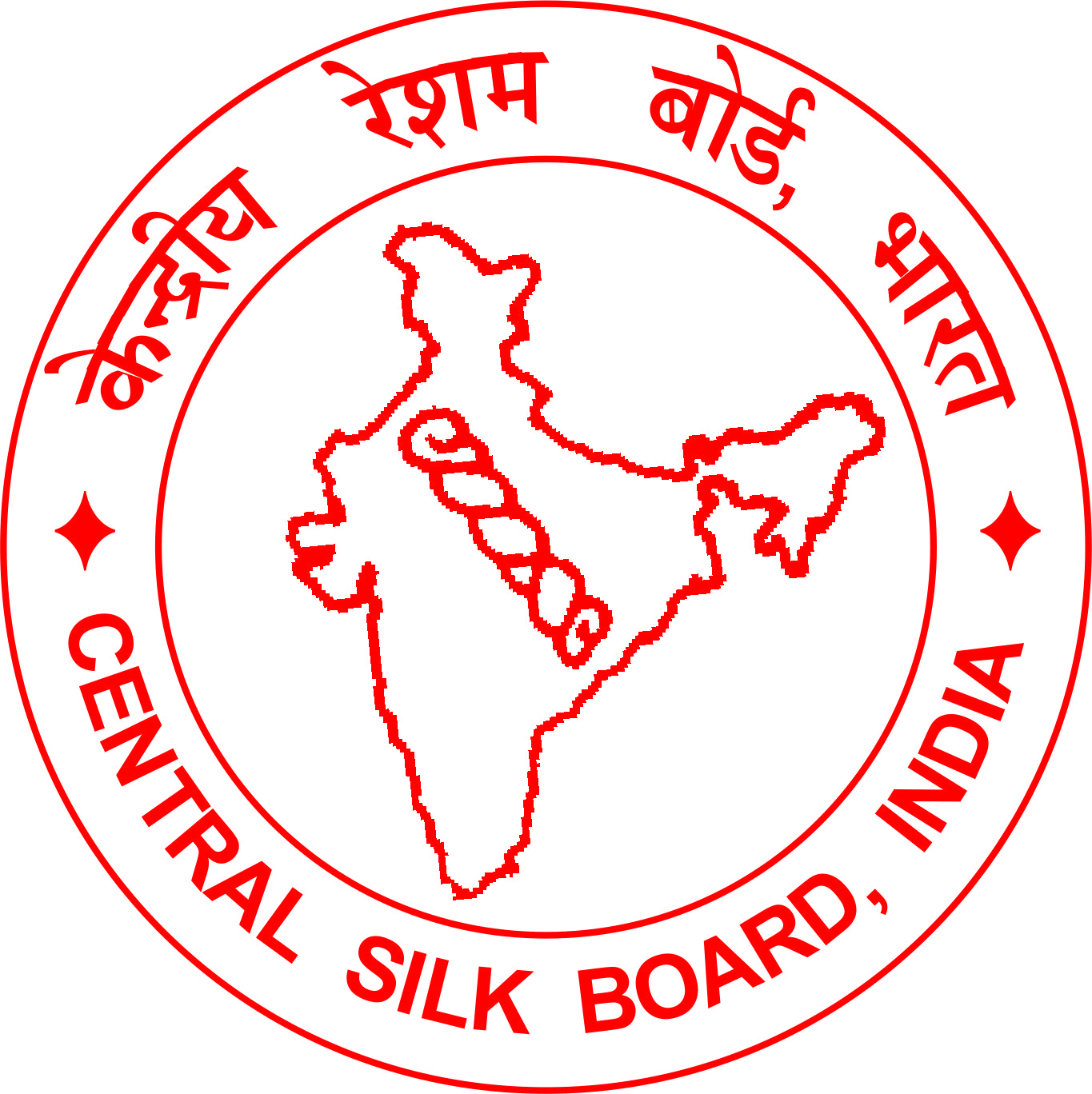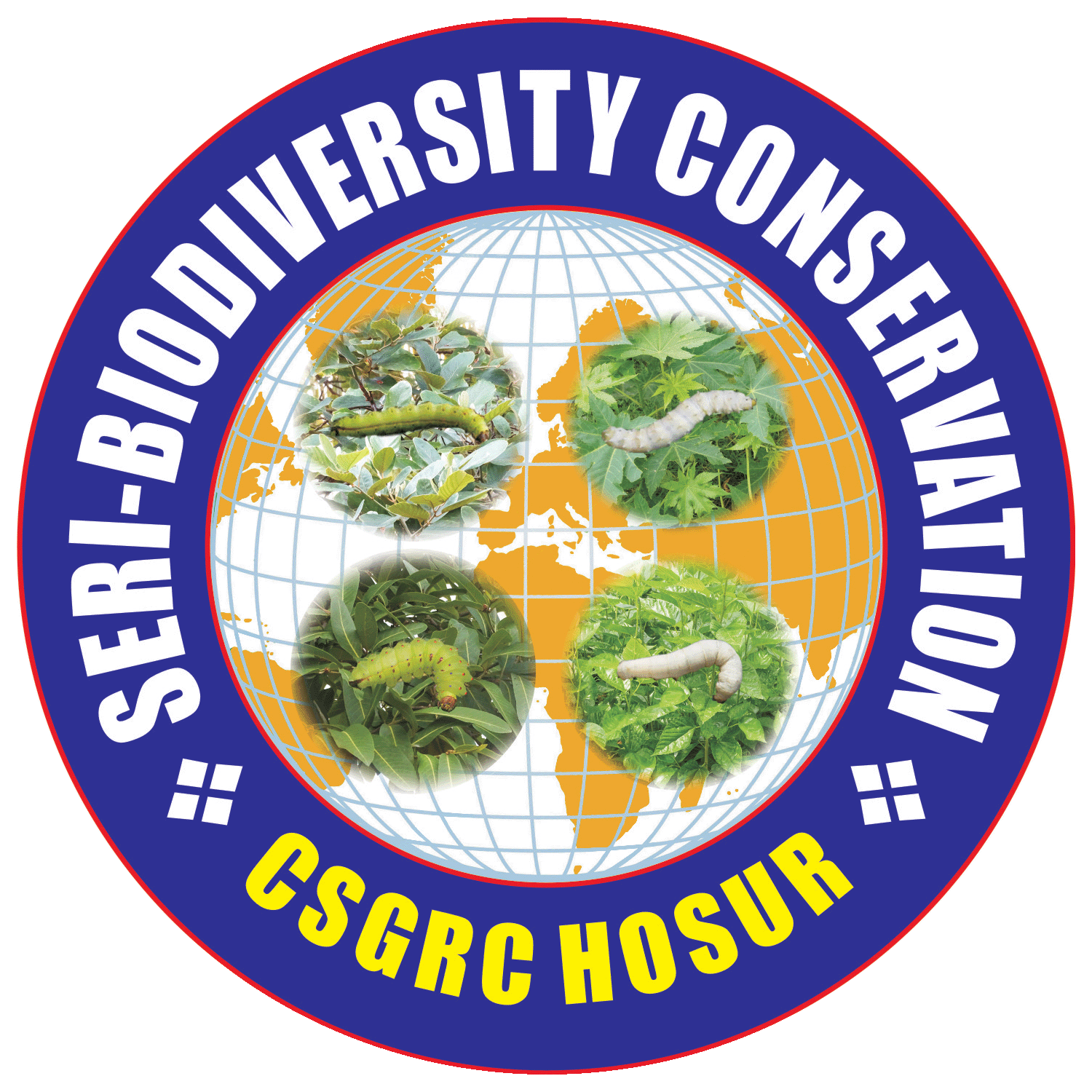CSGRC Overview
Biodiversity conservation programmes have drawn the attention of many countries because of the genetic erosion due to indiscriminate use of bio resources and damage to the environment, human interference in ecosystem, destruction of forest upsetting the equilibrium of the biosphere. The Convention on Biological Diversity (CBD) organised by United Nations Conference on Environment and Development (UNCED) in 1992 made an awakening call to draw the global attention and gene bank maintenance have gained greater momentum and considered as “Common Heritage of Mankind” and “Sovereign Right of Nations”. The conservation of genetic resources is now accepted as an essential responsibility of national governments.
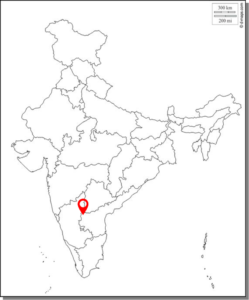
- Germplasm banks play a crucial role in the conservation and use of biodiversity. Conservation of the biodiversity commonly known as “ Library of Life” is of global importance . Seri-biodiversity is one of the specific components of agri-biodiversity related to the variability of sericigeneous insects and its host plants.Conservation of wild as well as domesticated seri-biodiversity resources are essential for development of sericulture which can sustain only through effective and systematic conservation of serigenetic resources.
- In view of the above, Central Silk Board, Bangalore initiated the establishment of Silkworm & Mulberry Germplasm Station (SMGS) at Hosur (Tamil Nadu) during April 1990 under the World Bank aided National Sericulture Project for the collection, characterization, evaluation and preservation of silkworm and mulberry genetic material. After acquisition of about 60 acres of land from Govt. of Tamil Nadu at Hosur, a small field office was opened at Hosur on 14th November, 1991and conservation activities were set in motion. To give a national posture, the Institute was renamed as Central Sericultural Germplasm Resources Centre during 1999.
- During 1999-2000, the centre was officially recognized as the nodal agency for mulberry and silkworm germplasm of the country with entire responsibility of mulberry and silkworm genetic resources management. It also became the nodal agency for registration of serigenetic resources in order to protect breeder’s/nation’s rights.The centre was recognized as National Active Germplasm Site of NBPGR under ICAR system.Over the course of 32 years, the Institute has heightened in its conservation efforts keeping the objective of sustainable sericulture in the forefront.
Since inception, it has conducted over 84 independent as well as collaborativesurveys and explorations in different parts of the country and collected wild and cultivated mulberry genetic resources (MGRs). At present, the field gene bank at CSGRC is maintaining 1317 MGRs out of 1032 are indigenous and 285 are exotic accessions. These accessions have been collected phase-wise and represent collections from 29 different countries and 31 states and union territories of India. The MGRs have been evaluated for propagation traits, growth and yield traits, and biochemical parameters. Characterization of the collections is categorically done for 19 morphological descriptors, 14 anatomical descriptors, and 26 Reproductive descriptors. The collected accessions have been assigned National Accession numbers by NBPGR, New Delhi.
- Further, the institute has collected and presently conserves 489 mulberry silkworm genetic resources (SWGRs) out of which 383 are bivoltine, 83 multivoltine and 23 are mutant genetic stocks, collected from 18 donors representing 14 countries. The accessions were collected along with passport data from the donor institutes. Characterization of SWGRs follows 43 morphological descriptors. Evaluation parameters viz. quantitative as well as qualitative rearing and reeling traits are also recorded while rearing the silkworm accessions at each cycle.The collected accessions have been assigned National Accession numbers by NBAIR, Bangalore.
- The informatic division has developed software packages of Silkworm and Mulberry Germplasm Information System which covers all types of passport data, collection data, information updating, descriptor preparation and query based facilities.Statistical modules of MGIS and SGIS were updated with necessary statistical tools for evaluation of germplasm. Later, both the software packages were made available in Windows platform, making it more efficient and user-friendly. Software packages for preparation of hibernation schedules for silkworm accessions and management of germplasm supply data were developed. The germplasm information is hosted in the official website of CSGRC for ease of access to the stakeholders.
- Apart from the mandated activities of collection, characterization, evaluation and conservation of germplasm material, it has engaged in rigorous research and developmental activities by application of basic genetics principles, biochemical aspects as well as biotechnological interventions to generate more information on the germplasm materials and thereby enhance their utility for improved sericulture. Activities in collaboration with CSB as well as non CSB R&D Institutes, universities have been carried out in diverse research areas. MOUs with IT companies are in effect to carry out ongoing next generation sequencing work. Focussed research is carried out to address the issues of climate change and its impact on the performance and sustainability of serigenetic resources. Continued efforts are being made for cryopreservation for long term preservation of the valuable genetic resources. Emphasis is being laid on byproduct utilization in sericulture and scope of commercialization is being explored. The Institute was recognized as Advanced Research Centre for conducting studies leading to doctoral degree by University of Mysore and then by Periyar University, Tamil Nadu (2018).
The Organisation and Infrastructure
The organizational set up of the institute includes two major scientific divisions viz., Mulberry Division and Silkworm Division. Scientists, Technical and Administrative personnel and Skilled Farm Workers are working under this institute. The main building comprises well-equipped research laboratories of mulberry, silkworm divisions, tissue culture, biochemistry and biotechnology, administrative office, informatics section, museum, auditorium, library and canteen. The centre is equipped with a cold storage plant in the campus, advanced microscopes, laminar flow chambers, leaf area meter, PCR machines, tissue culture and cryo-preservation units, spectrophotometer, nitrogen analyzer, portable photosynthesis system, CO2 incubator, Real-time PCR machine, and other essential equipments required for different research projects.
Altogether, 20.0 acres of land is under mulberry cultivation including mulberry ex-situ Field Gene Bank(FGB-9.0 acres). Three rearing houses with 400-500 dfls rearing capacity in each house are available. A grainage with pebrine testing facilities is also developed for silkworm seed preparation and moth examination. A Post Cocoon Evaluation Section supported with boiler and silk reeling machine from Japan is also available.
To meet the objectives of a display centre for mulberry and silkworm germplasm resources, a unique and rich museum has been established. A biodiversity live museum of mulberry and silkworm genetic resources has been developed with 14 different Morus species. A herbarium with specific details on the mulberry germplasm is available.
Collection and conservation of Mulberry Genetic Resources
Country-wise collection of Mulberry germplasm
- Afghanistan (3), Australia (2), Bangladesh (5), China (55), Cyprus (1), Egypt (3), France (32), Hungary (1), India (1032), Indonesia (8), Italy (7), Japan (72), Myanmar (7), Nepal (1), Pakistan (8), Papua New Guinea (1), Paraguay (4), Philippines (1), Portugal (1), Russia (1), South Korea (6), Spain (2), Sri Lanka (2), Thailand (11), Turkey (1), USA (4), Venezuela (1), Vietnam (5), Zimbabwe (11), and Others (28).
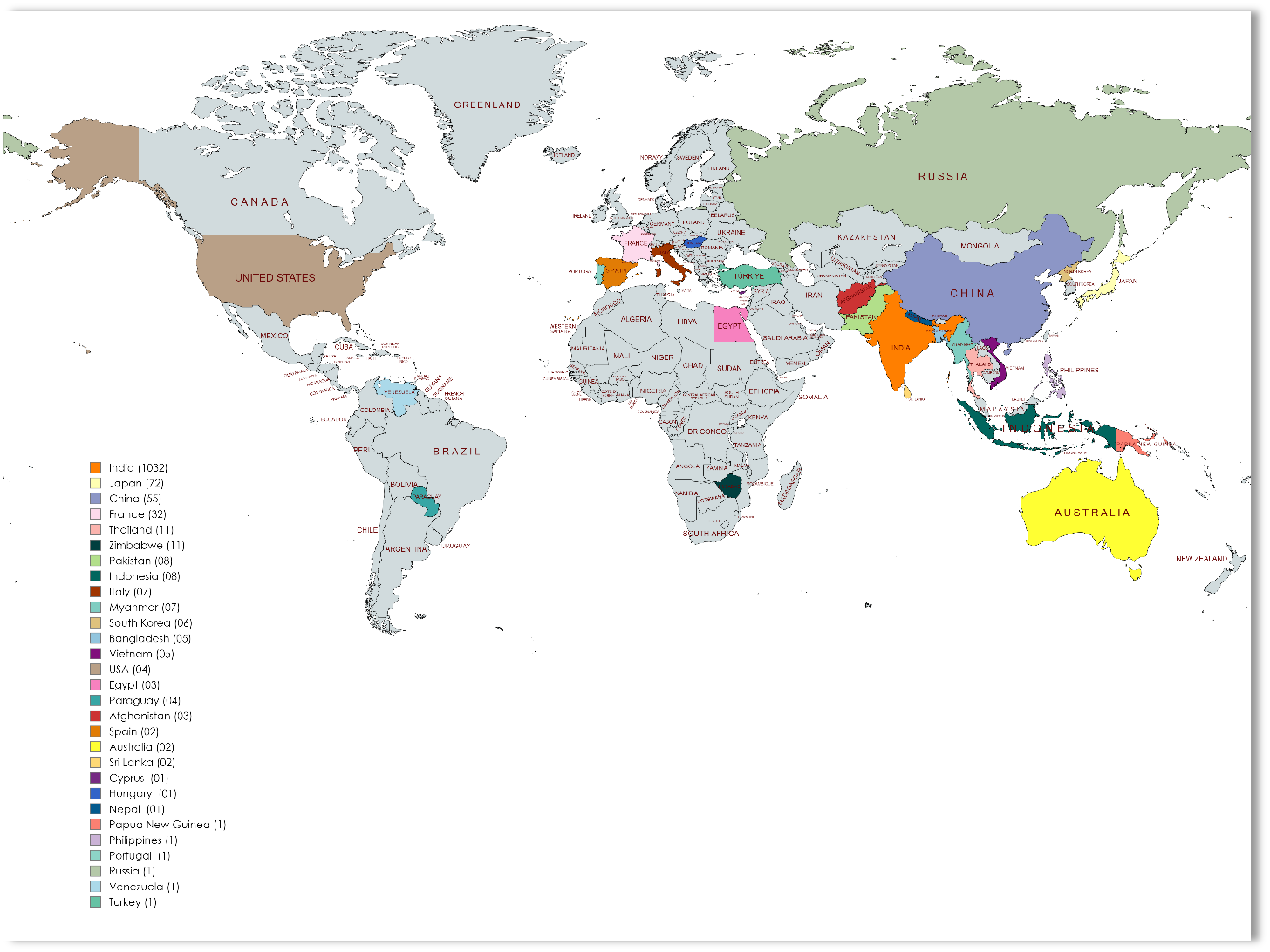
State-wise collection of Mulberry germplasm
- A & N Islands (15), Andhra Pradesh (4), Arunachal Pradesh (11), Assam (11), Bihar (9), Chhattisgarh (4), Goa (11), Gujarat (16), Haryana (13), Himachal Pradesh (36), Jammu & Kashmir (41), Jharkhand (17), Karnataka (161), Kerala (71), Madhya Pradesh (12), Maharastra (32), Manipur (12), Meghalaya (37), Mizoram (8), Nagaland (9), New Delhi (3), Orissa (1), Pondicherry (4), Punjab (18), Rajasthan (65), Sikkim (15), Tamil Nadu (86), Tripura (3), Uttar Pradesh (146), Uttaranchal (8), and West Bengal (153)
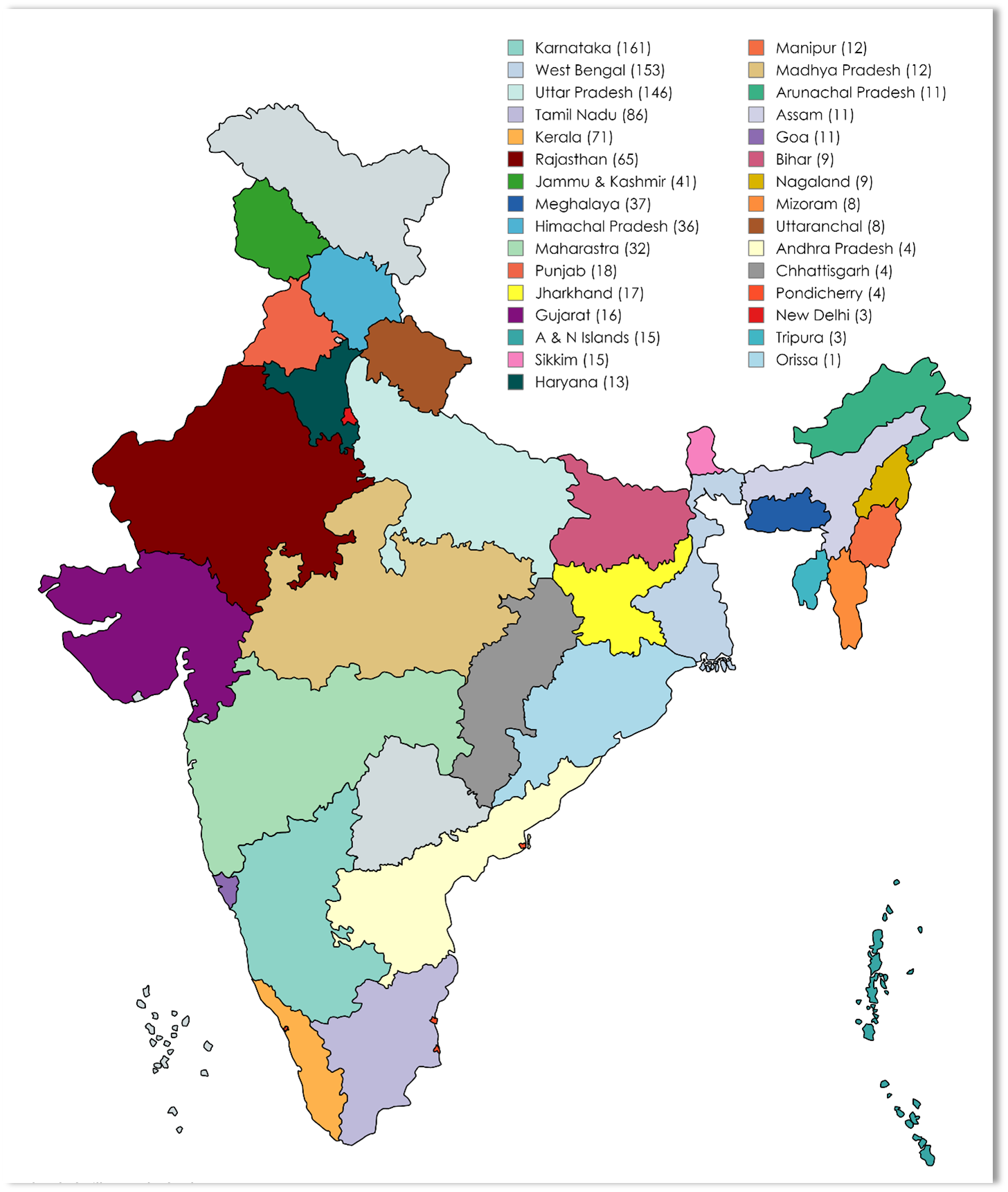
Mulberry National Cryo Gene Banking
- A total of 338 mulberry accessions were cryo-preserved at National cryo gene bank (–196°C), ICAR-NBPGR, New Delhi using dehydration and slow freezing technique.
- Regeneration of cryopreserved mulberry germplasm accessions after 1~3 years of storage indicated no survival loss over different years of storage.
- Genetic stability of cryopreserved mulberry germplasm was also confirmed using molecular markers.
Mulberry Trait Specific Accessions
Trait-specific mulberry accessions including High leaf yield and biomass (20 accessions), High harvest index (17), High water retention capacity (20), High rooting (30), High ranking for multiple traits on growth traits (15), Tropical Alkaline Irrigated (09), Tropical Hot And High Humid (04), Tolerant to cold (04), Drought (17), Salinity (20), Biotic Stress –Tukra (08) and Powdery mildew (20) have been identified.
State-wise collection of Mulberry germplasm
- Bangladesh (3 accessions), Brazil (3), China (44), France (11), India (327), Indonesia (1), Iraq (1), Japan (67), Poland (3), Russia (19), South Korea (1), Thailand (4), Ukraine (2), Vietnam (3)
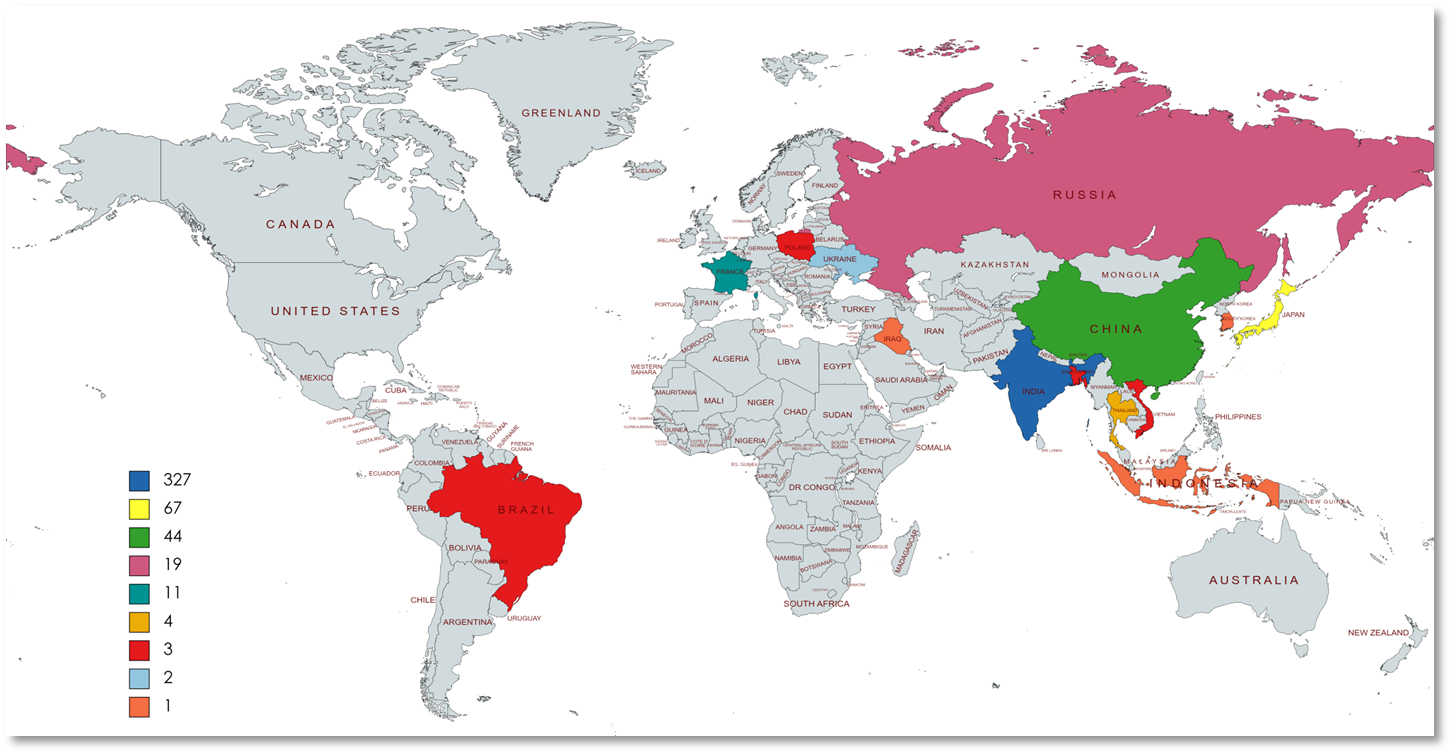
State-wise collection of Mulberry germplasm
- Andhra Pradesh (9), Assam (6), Jammu & Kashmir (87), Karnataka (123), Maharashtra (2), Tamil Nadu (20), Uttar Pradesh (10), Uttarakhand (6), West Bengal (64)

Silkworm Trait Specific Accessions
- Trait-specific accessions include accessions suited for temperate region (2 BV) Sub tropical region (5 BV), Tropical region (2 BV), Temperate and tropical region (1 BV), Southern zone (3 BV), Eastern zone (3 BV), High temperature and high humidity (autumn - 4 BV), High temperature and low humidity (4 BV & 4 MV), Tolerant to BmBDV (20 BV & 2 MV), Tolerant to BmNPV (12 BV & 3 MV).
Collection and conservation of Mulberry Genetic Resources
- Survey, exploration and collection in different geographical regions of the country.
- Characterization and evaluation of the germplasm for morphological, reproductive, anatomical, biochemical, growth and yield and molecular parameters.
- Mulberry cytology and ploidy-associated trait analysis.
- Evaluation of germplasm for identification of elite germplasm and screening against biotic (resistance/tolerance to pathogens) and abiotic stresses (water and nitrogen efficiency, drought, saline and alkaline tolerance, thermotolerance).
- Ex situ conservation and Cryo-preservation of mulberry, silkworm and promoting in situ
- Utilization of germplasm adopting different schedules and supply to different universities and research institutes of the country.
- Identification of region and season specific germplasm through multi-locational trials in different agro-ecological regions.
- Registration and national accessioning of sericultural germplasm.
Other Services
- Well characterized and evaluated mulberry and silkworm germplasm are supplied to the scientists to work on crop improvement programme and also to other needy users to promote ad enhance germplasm utilization.
- Centre is providing training to the scientists involved in the germplasm management and the sericultural farmers. The centre encourages study/field visits for stakeholders besides imparting need-based trainings to graduate and post-graduate students.
- In order to give due recognition to the scientists and also popularize the varieties/breeds evolved by them, centre is carrying out registration of the germplasm.
Other R&D institutes/facilities available nearby
- Cold Storage Plant (CSP), NSSO, CSB, Hosur (inside CSGRC, Campus)
- Eri Silkworm Seed Production Centre (ESSPC), Hosur
- Tamil Nadu Sericulture Training Institute (TNSTI), Hosur
- Silkworm Seed Production Centre (SSPC), SIPCOT, Hosur
- Institute of Bioinformatics and Applied Biotechnology (IBAB), Bengaluru
- Regional Sericultural Research Station (RSRS), CSB, Kodathi
- Silkworm Seed Technology Laboratory (SSTL), CSB, Kodathi
- Seri-Biotech Research Laboratory (SBRL), CSB, Kodathi
- Central Silk Board, Bengaluru
- National Silkworm Seed Organization (NSSO), Bengaluru
- Central Silk Technological Research Institute (CSTRI), CSB, Bengaluru
- Silk Mark Organization of India (SMOI), CSB, Bengaluru
- Karnataka State Sericulture Research and Development Institute (KSSR&DI), Thalaghattapura, Karnataka
- Indian Institute of Science (IISc), Bengaluru
- National Bureau of Agricultural Insect Resources (NBAIR), Bengaluru
- Gandhi Krishi Vigyana Kendra (GKVK), UAS, Bengaluru
- Indian Institute of Horticultural Research (IIHR), Hesaraghatta, Bengaluru


